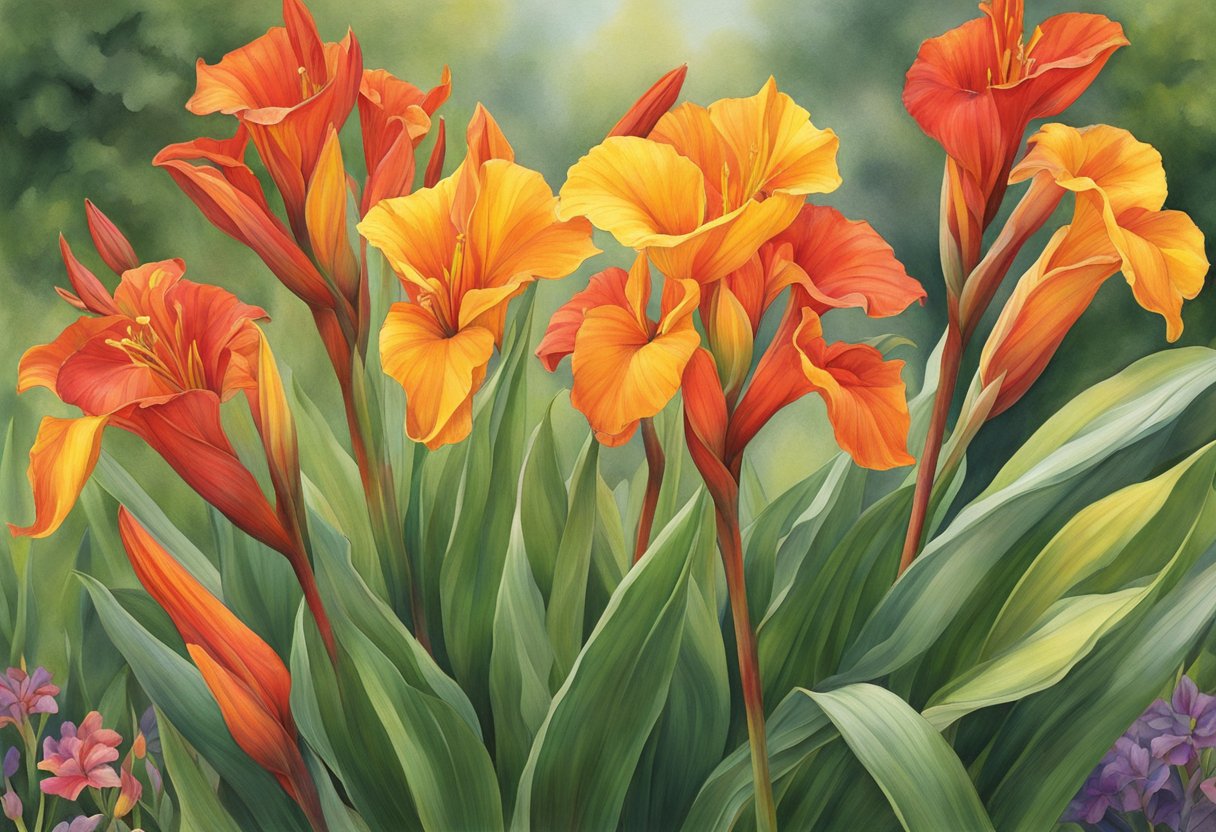Canna lilies, with their lush tropical foliage and vibrant blooms, bring a touch of the exotic to gardens and landscapes. As a fervent gardener, I’ve always admired the bold statement these plants make wherever they’re grown. The longevity of a canna lily’s bloom is an important consideration when planning a garden to ensure a continuous display of color.

Typically, canna lilies bloom from late spring or early summer through the first frost, which can be 6-8 weeks per individual flower stalk. However, as a whole, the plant may offer its flamboyant show for several months when properly cared for and deadheaded regularly.
The blooming period of a canna lily not only relies on climatic factors but also on the variety and care provided. My experience shows that ensuring the right conditions for the plant, like proper sunlight, warm temperatures, and adequate water, play a crucial role in maximizing the flowering season. Regular deadheading extends the blooming and encourages new growth, thus helping gardeners like myself to enjoy their flamboyant display throughout the growing season.
JUMP TO TOPIC
Choosing the Right Conditions for Cannas
💥 Moisture: Cannas require moist soil, but it’s a delicate balance to avoid waterlogging. I ensure the soil stays consistently moist without drowning the roots.
Cannas love heat and perform well in temperatures between 70°F and 90°F. They are tropical plants and are hardy in USDA zones 7 to 10. In colder regions, I plant them after the threat of frost has passed, and I lift rhizomes before the first frost in fall.
| Condition | Preference |
|---|---|
| Light | Full sun to Partial shade |
| Soil | Rich, well-draining, pH 6.0-6.5 |
| Moisture | Consistently moist soil |
| Temperature | 70°F – 90°F (USDA zones 7-10) |
Choosing a suitable location is paramount. My cannas are positioned where they can bask in the sun’s warmth while having protection during the peak heat in extremely hot areas. This strategic placement encourages their vivacious blooms to last throughout their flowering season.
Planting and Caring for Canna Lilies
Growing canna lilies successfully starts with proper planting and ongoing care. I’ll provide the essential techniques and maintenance practices to keep your canna lilies vibrant and blooming throughout the summer.
Proper Planting Techniques
When to plant: Plant canna lily rhizomes in the spring after the last frost when the soil has warmed, ideally at least 65°F (18°C).
How to plant: Choose a location with full sun and well-draining soil enriched with compost or well-rotted manure. Dig a hole 2 to 4 inches deep and place the rhizome with eyes pointing upwards. Cover with soil, tamp firmly, and water well.
Daily Care and Maintenance
For the best blooms, canna lilies require consistent care. Here’s a simplified daily care guide:
- Watering: Canna lilies love moisture. Water them regularly to keep the soil consistently moist but not waterlogged.
- Fertilization: Feed canna lilies with a balanced fertilizer once a month during the growing season to support their vigorous growth and floriferous nature.
- Mulching: Apply mulch around the base to retain moisture, regulate soil temperature, and reduce weed growth.
- Deadheading: Remove spent flowers (deadheading) to encourage more blooms.
Common Pests and Problems
Canna lilies are robust but sometimes face pest and disease challenges:
- Pests: Keep an eye out for slugs, caterpillars, and Japanese beetles that can damage the foliage and flowers.
- Diseases: Watch for signs of fungal diseases, which can be mitigated by proper air circulation and avoiding overhead watering.
Over-watering and poor drainage are the most common issues that lead to rhizome rot. Ensure your planting site and pot have good drainage.
Maximizing Blooms and Growth
To get the most out of your canna lilies during their bloom time, a strategic approach to fostering their growth and stimulating their blooms is essential. Let’s discuss how to keep these beauties in top blossoming form throughout their growing season.
Stimulating and Prolonging Blooms
To encourage canna lilies to bloom, providing ample sunlight and heat is crucial. I ensure they get at least six hours of full sun daily. If the weather is hot enough—canas love heat—a light shade in the afternoon can prevent scorching. Regular fertilizing helps too; I use a high-phosphorus mix at the start of the growing season to promote vibrant blooms.
Pruning and Deadhead to Encourage Growth
Canna lilies benefit greatly from pruning and deadheading. I carefully remove spent blooms to prevent the plant from going to seed, which can reduce flowering. By deadheading, the plant is encouraged to produce more blooms. As for pruning, I trim back foliage that is damaged or dying to redirect energy to growth and blooming. This also helps maintain the plant’s striking appearance, emphasizing both its blooms and lush foliage.
Overwintering and Propagation
To ensure continuous bloom each season, proper overwintering and propagation of canna lilies are essential. My focus here is to share the specific methods that prepare these perennials for a dormant period and the steps to multiply them successfully.
Overwintering Techniques for Canna Lilies
<|diff_marker|> — assistant












